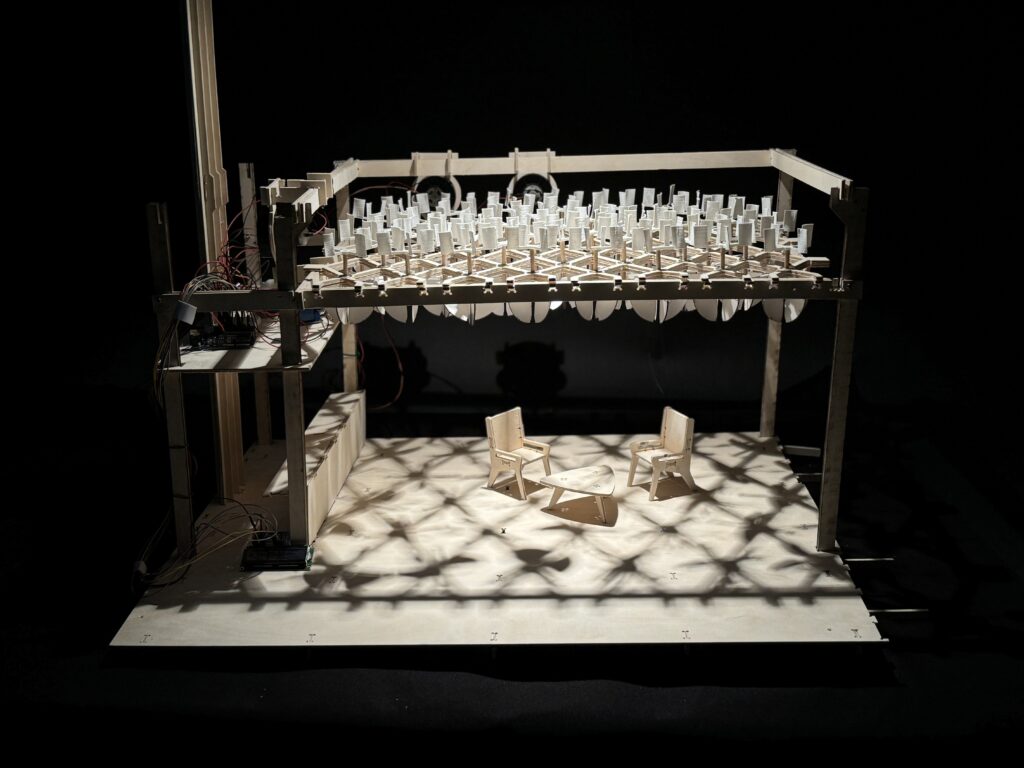The Horizon is an open space, spanning 110m x 37m (length of a whole block of Barcelona) that guides human behaviour around changing shadow patterns, which are driven by the sun’s heat. It rests on the top of the student housing building, housing all the communal areas.
Communal activities around the Horizon shift, with moveable furniture and acoustically insulating panels that create microspaces adapting to the patterns and gradients of shade. There is no determined layout, allowing for it to be formed organically, following the shaded patterns.
How the space looks at one time in the day is completely different to how it looks in the next hour, or day, or month.
It’s composed of communal spaces, with lounges, multi-use creative spaces, shared kitchens and communal eating spaces, group study areas, to quiet study areas and quiet contemplation spaces
Above it, there are vegetable patches allocated to each student to engage with the process of food production and care.
The building creates spaces to address the main factors to make not just health but vitality.
Nutrition, Movement, Community, Nature, Work, Play/Pleasure, and Sleep.
It started with a hair dryer.
it evolved to making energy visible through shadows, and created a space to appreciate these energies and dynamic forces
The machines made the energy visible through the shadows, but we initially couldn’t control these shadows.
Until we found how to control them.

In the Machine Room Gradients of shade were guided by the direction and strength of the wind. Different locations for the hair dryers created different shading patterns, which users adapted to with moveable furniture.
The wind force and wind direction determine the type of shade. Which in turn determine the patterns of inhabitation. And what if this was scaled from one room to a whole building?
Responding to the site in Barcelona, where the wind blows less than 20% of the time, the building uses the sun to create shading from the sun.
With solar chimneys, black tinted solar panels capture heat on the top of the chimney, while also generating electricity. this rising hot air drives passive ventilation through the building, and uses this ventilation to drive propellers that make shading patterns on the enormous horizontal surface
The tilted roof is designed for rainwater catchment.
The rooms are laid out underneath the Horizon, on the periphery to receive outside sunlight.
Students affect the shading of the Horizon above. /// through the opening of the room windows, air enters the building through shafts that connect to the solar chimneys.

With the design, the building addresses the main elements of self sufficiency. Rainwater is caught to aid building functions, Electricity is generated with solar panels on the solar chimneys, Food is made at a small scale with vegetable patches the each student takes responsibility for and manages, carbon is stored in the timber structure, small composting areas next to the vegetable patches create an awareness of waste circularity, and passive thermal regulation is provided by the solar chimneys. By addressing the elements of self sufficiency and human vitality, while creating a space for experiencing, appreciating and reconnecting with the dynamic forces of nature, the building proposes a new way of inhabiting space that’s guided by climate and the rhythms of nature.
It’s a space where seasonal and hourly climatic changes create patterns that lead the users to adapt their behaviors to these changes.

